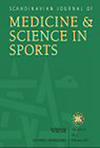自然经期耐力训练的女性运动员在低强度和高强度训练后的跑步经济性:FENDURA项目
IF 3.5
2区 医学
Q1 SPORT SCIENCES
引用次数: 0
摘要
维持跑步经济性的能力通常是在长时间的连续运动中评估的,目前尚不清楚月经周期是否会成为一个混杂因素。本研究的第一个目的是评估女性运动员在典型的1小时低强度(LIT)和高强度训练(HIT)期间保持跑步经济性的能力。第二个目的是调查月经周期阶段是否影响维持跑步经济性的能力。自然月经耐力训练的女性在三个不同的月经周期阶段:卵泡早期、排卵期和黄体中期进行了三次LIT (n = 16)(最大增量试验中达到的最大速度的45%-55%)和/或三次HIT (n = 17) (5 × 4分钟,最大增量试验中达到的最大速度的80%)。在每次会议之前和之后确定运行经济性。运行经济性,表示为能源成本(以前:1.34;后:1.34 kcal/kg/km, p = 0.797)和氧耗(前:272,后:273 mL/kg/min, p = 0.348),与后无显著差异。能源成本(1.33以前;后:1.34 kcal/kg/km, p = 0.130),但有氧消耗(前:269;后:274 mL/kg/km, p <;0.003)盘后小幅走高。月经周期阶段不混淆维持经期的能力。运行经济性可以在典型的1小时LIT会话期间保持。在典型的HIT会话期间保持运行经济性的能力取决于所使用的表达式;能量消耗不受影响,而氧气消耗可能在HIT会话后略有增加。本文章由计算机程序翻译,如有差异,请以英文原文为准。
Running Economy After a Low‐ and High‐Intensity Training Session in Naturally Menstruating Endurance‐Trained Female Athletes: The FENDURA Project
The ability to maintain running economy is generally evaluated during a long continuous exercise bouts, and it is unclear whether the menstrual cycle phase acts as a confounder. The first aim of this study was to evaluate the ability to maintain running economy during typical 1‐h low‐ (LIT) and high‐intensity training (HIT) sessions in female athletes. The second aim was to investigate whether menstrual cycle phase affected the ability to maintain running economy. Naturally menstruating endurance‐trained females performed three LIT (n = 16) (45%–55% of the maximal velocity achieved during the maximal incremental test) and/or three HIT sessions (n = 17) (5 × 4 min at 80% of the maximal velocity achieved during the maximal incremental test) during three distinct menstrual cycle phases: early follicular, ovulatory, and mid luteal. Running economy was determined before and after each session. Running economy, expressed as energy cost (before: 1.34; after: 1.34 kcal/kg/km, p = 0.797) and oxygen cost (before: 272, after: 273 mL/kg/min, p = 0.348), was not significantly different before versus after the LIT session. Energy cost (before 1.33; after: 1.34 kcal/kg/km, p = 0.130) was not significantly different before versus after the HIT session, but oxygen cost (before: 269; after: 274 mL/kg/km, p < 0.003) was slightly higher after the session. Menstrual cycle phase did not confound the ability to maintain running economy. Running economy can be maintained during a typical 1‐h LIT session. The ability to maintain running economy during a typical HIT session depends on the expression used; energy cost was unaffected, while oxygen cost may be slightly increased after HIT sessions.
求助全文
通过发布文献求助,成功后即可免费获取论文全文。
去求助
来源期刊
CiteScore
7.90
自引率
4.90%
发文量
162
审稿时长
3 months
期刊介绍:
The Scandinavian Journal of Medicine & Science in Sports is a multidisciplinary journal published 12 times per year under the auspices of the Scandinavian Foundation of Medicine and Science in Sports.
It aims to publish high quality and impactful articles in the fields of orthopaedics, rehabilitation and sports medicine, exercise physiology and biochemistry, biomechanics and motor control, health and disease relating to sport, exercise and physical activity, as well as on the social and behavioural aspects of sport and exercise.

 求助内容:
求助内容: 应助结果提醒方式:
应助结果提醒方式:


